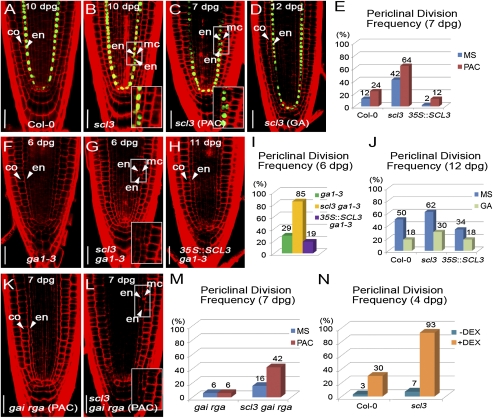Fig. 3.
Control of the formative ground tissue division in the MZ by the interaction of SCL3 and GA/DELLA pathways. MC formation in Col-0 (A) and scl3 roots (B) at 10 dpg. The scl3 root exhibited the additional formative periclinal division giving rise to endodermis (en) and middle cortex (mc). Arrowheads indicate endodermis (en), middle cortex (mc), and cortex (co), respectively. The nascent MC layer loses the endodermis identity marked by pSCR::GFP-SCR (Insets in B and C). Occurrence of the formative division in scl3 in the presence of 1 μM of PAC (C) and 10 μM of GA3 (D). The treatment with PAC increased, whereas exogenous GA3 decreased the MC formation. (E) Quantitative evaluation of MC formation confirms that GA deficiency causes an increased frequency of MC formation in Col-0, scl3, and 35::SCL3. In addition, loss and gain of SCL3 function also have opposing effects on the MC formation: increase in scl3 and decrease in 35::SCL3. (F–I) Occurrence of MC formation in ga1-3, scl3 ga1-3, and 35::SCL3 in ga1-3. Similarly, the frequency of the formative division was also modulated by loss and gain of SCL3 function. (J) Quantitative evaluation of MC formation confirms that exogenous bioactive GA, conversely, decreases the frequency in Col-0, scl3, and 35::SCL3. (K–M) MC formation in gai rga and scl3 gai rga in the absence or presence of 1 μM of PAC. As predicted, gai rga roots were extremely resistant to PAC, whereas scl3 gai rga triple mutants showed far more increased occurrence of the formative division in the presence of PAC. (N) In the absence or presence of DEX, the pSCR::gai-GR-YFP seedlings in Col-0 and scl3 were grown in MS agar plates for 4 d, transferred to MS agar plates supplemented with or without 10 μM of DEX, and incubated for 12 h. In the presence of DEX (+DEX), pSCR::gai-GR-YFP seedlings in scl3 showed a dramatically increased frequency of MC formation compared with pSCR::gai-GR-YFP seedlings in Col-0. (Scale bar, 30 μm.)

